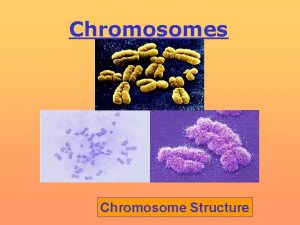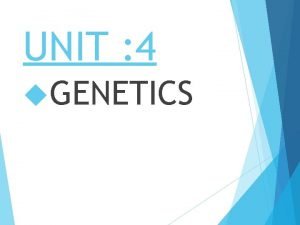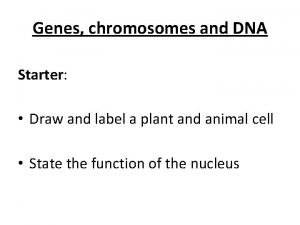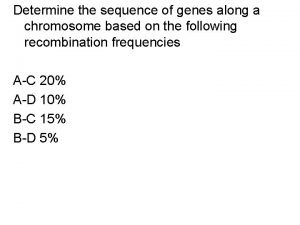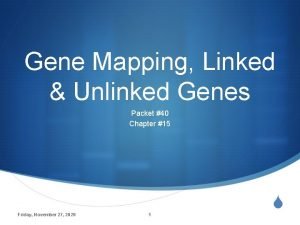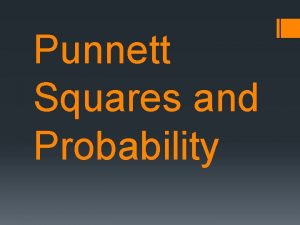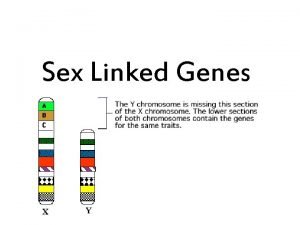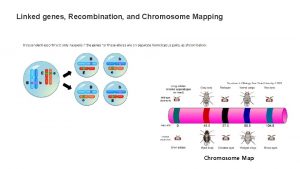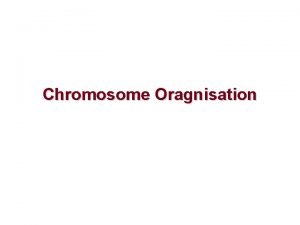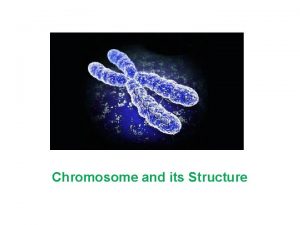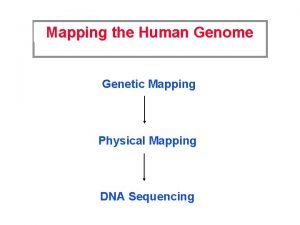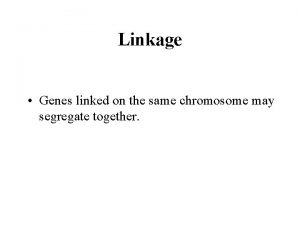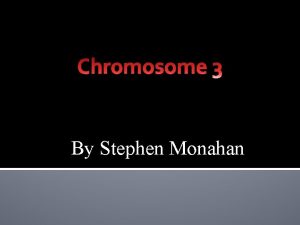Genetic Mapping Linked Genes The chromosome Several genes

















- Slides: 17

Genetic Mapping Linked Genes

The chromosome • Several genes or alleles are found on each chromosome at a particular locus (position) Locus

Recombinants • Recombinants- offspring that exhibit genotypes different from either parent

Mendelian Inheritance • Genes that follow Mendel’s inheritance patterns are not on the same chromosome y y Y y r r R r

Genotype ratios come out as expected

Linked Genes • Linked genes- genes that are on the same chromosome and are generally inherited together (don’t follow Mendel’s laws)

Recombinant Frequency • When a lower percentage of recombinants show up than was expected, we know that genes are linked. (or a higher percentage of parental types)


Linkage Map • An order of gene loci along a chromosome based on recombinant frequencies (the further apart the chromosomes are, the higher the probability of them crossing over)


Testing Recombinant Frequencies • A Chi Square test can be done to see if there is a statistical difference in what you expect and what you observe. N=Normal wings n=wingless flies Nn x Nn Expected ? Observed 522 winged 202 wingless

1 st Make a null hypothesis • A null hypothesis says that there is no difference between what you expect and what you observe Is there a difference ?

2 nd Run the numbers • X 2= Σ(o-e)2 e

3 rd Get you values • X 2= calculated chi square value • df=degrees of freedom- the number of categories (n) minus 1 • Confidence interval- how sure you can be in the outcome (we usually use 95%)


4 look up your values • Look up you values in the table. If your chi square value is less than the value on the table than except the null hypothesis.

Analyze • An accepted null means what you expected is what you observed • A rejected null means what you expected is significantly different that what you observed.
 Linked genes and unlinked genes
Linked genes and unlinked genes Polygenic inheritance
Polygenic inheritance How to read chromosome
How to read chromosome Genes chromosome
Genes chromosome Chromosome vs dna vs gene
Chromosome vs dna vs gene How to determine the sequence of genes along a chromosome
How to determine the sequence of genes along a chromosome Chromosome 19
Chromosome 19 What is this?
What is this? Genetic drift vs gene flow
Genetic drift vs gene flow Genetic drift vs genetic flow
Genetic drift vs genetic flow Gene flow vs genetic drift
Gene flow vs genetic drift Genetic programming vs genetic algorithm
Genetic programming vs genetic algorithm Genetic programming vs genetic algorithm
Genetic programming vs genetic algorithm Glomerulus
Glomerulus Linked genes
Linked genes Linked vs unlinked genes
Linked vs unlinked genes How to do sex linked punnett squares
How to do sex linked punnett squares What are sex linked genes
What are sex linked genes


